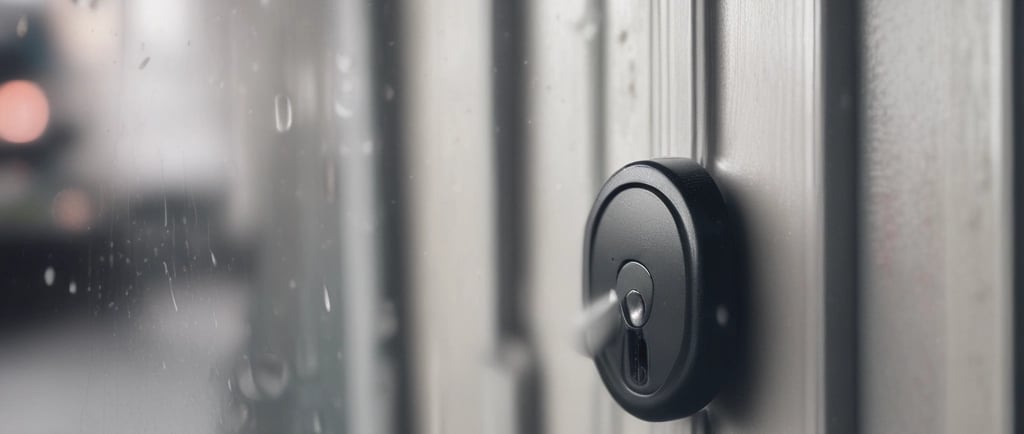Smart locks vs traditional locks: which is better for Melbourne's weather?
Discover how smart locks handle Melbourne's unpredictable weather compared to traditional locks. Expert comparison on durability, maintenance, and performance in rain, heat, and humidity.
SMART LOCKS MELBOURNE WEATHERWEATHER RESISTANT LOCKS MELBOURNEIP65 LOCKS AUSTRALIASMART LOCK DURABILITYMELBOURNE CLIMATE LOCKS
10/28/20252 min read


Melbourne's weather is famously unpredictable—four seasons in one day isn't just a saying. From scorching 40°C summer days to freezing winter mornings, torrential rain to dust storms, your door locks face constant challenges. If you're considering a smart lock, you might wonder: can they really handle Melbourne's extreme weather better than traditional locks? Let's compare.
Understanding Melbourne's Climate Challenges
The Weather Extremes Your Locks Face:
Temperature Fluctuations
Summer: 35-45°C in extreme heat waves
Winter: Down to 0°C on cold mornings
Daily swings of 15-20°C are common
Metal expansion and contraction affects lock mechanisms
Moisture & Humidity
Average humidity: 50-70%
Coastal suburbs experience even higher levels
Morning dew and fog are frequent
Heavy rainfall throughout the year
Dust & Pollen
Spring pollen storms
Dry summer dust
Coastal salt air in bayside suburbs
These particles infiltrate lock mechanisms
UV Exposure
Intense Australian sun damages exterior components
Fading and material degradation
Plastic and rubber seal deterioration
Traditional Locks in Melbourne Weather
How They Perform:
Strengths:
Simple mechanical design with fewer components to fail
No electronics to malfunction in extreme temperatures
Time-tested durability over decades
Lower upfront cost
Weaknesses:
1. Moisture Problems
Metal components rust and corrode over time
Internal mechanisms seize up in high humidity
Rain water can penetrate keyholes
Requires regular lubrication and maintenance
2. Temperature Sensitivity
Metal expansion in heat can cause keys to stick
Contraction in cold makes locks stiff and hard to turn
Freezing temperatures can lock mechanisms solid
Requires de-icing in winter mornings
3. UV Damage
Exterior finishes fade and peel
Plastic components become brittle
Aesthetics degrade over 5-10 years
Replacement often needed due to appearance, not function
4. Maintenance Requirements
Annual lubrication essential in Melbourne climate
Keys wear down and need replacement
Locksmith visits for adjustments
Average lifespan: 10-15 years with proper maintenance
Smart Locks in Melbourne Weather
Modern Weather Protection:
Advanced Engineering for Australian Conditions:
1. IP65 Weather Rating (IPM016)
IP6: Complete dust protection—no particles can enter
IP5: Protected against water jets from any direction
Tested for Australian weather extremes
Superior to traditional locks' exposure
2. Sealed Electronic Components
Waterproof housing protects circuitry
Moisture-resistant touchscreens
Corrosion-resistant materials (zinc alloy + steel)
O-ring seals prevent water ingress
3. Temperature Tolerance
Operating range: -20°C to +60°C
Electronics designed for extreme conditions
No metal-on-metal friction issues
Consistent performance in all temperatures
4. UV-Resistant Materials
Modern polymers resist sun damage
Powder-coated finishes don't fade
Maintains appearance for decades
Designed for harsh Australian sun
Real-World Performance:
Rain & Humidity
Smart locks continue working in downpours
No keyhole for water to enter
Sealed battery compartments
Auto-lock prevents leaving door vulnerable
Heat Waves
Electronics operate normally up to 60°C
No key sticking in extreme heat
Face ID and fingerprint work in all temperatures
Remote access when you don't want to go outside
Cold Snaps
Fingerprint sensors work with cold hands
App access means no frozen keys
Consistent mechanism operation
Battery life extends in cooler weather
Dust & Pollen
Sealed design prevents infiltration
No keyhole to collect debris
Easy-clean touchscreen surfaces
Maintains performance during pollen season
Head-to-Head Comparison
Weather Resistance
FeatureTraditional LocksSmart Locks (IPM016/IPC201)Rain ProtectionPoor - water enters keyholeExcellent - IP65 sealedHumidity ResistanceModerate - requires maintenanceExcellent - sealed electronicsTemperature RangeLimited - metal expansion issuesWide - operates -20°C to +60°CDust ProtectionPoor - particles enter mechanismExcellent - fully sealedUV ResistanceModerate - finishes fadeExcellent - UV-resistant materialsMaintenance NeedsHigh - annual servicingLow - battery replacement onlyLifespan in Melbourne10-15 years15-20 years
Maintenance Requirements in Melbourne Climate
Traditional Locks:
Lubricate keyhole every 6-12 months
Check for rust quarterly
Replace keys when worn
Professional servicing annually
Costs: $50-150/year
Smart Locks:
Battery replacement 1 every 2-4 years
Clean touchscreen monthly
Software updates (automatic)
Check weather seals annually
Costs: $20-40/year (batteries only)
Cost Analysis Over Time
10-Year Melbourne Weather Exposure:
Traditional Lock:
Initial cost: $150-300
Maintenance: $500-1,500
Key replacements: $50-100
Early replacement due to weather damage: possible
Total: $700-1,900
Smart Lock (IPC201):
Initial cost: $749 (installed)
Batteries: $200-400
Maintenance: minimal
2-year warranty included
Total: $949-1,149
Smart Lock (IPM016):
Initial cost: $1,099 (installed)
Batteries: $200-400
Maintenance: minimal
Superior weather protection
Total: $1,299-1,499
Smart locks offer better value considering weather durability, convenience, and security features.
